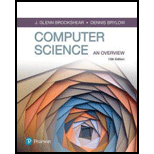
Concept explainers
Mass storage system:
The computers have limited size of main memory to store data. So, most of the computers have additional memory devices called as mass storage or secondary storage systems such as magnetic disks, CDs, DVDs, magnetic tapes flash drives, and so on. The mass storage devices such as CDs, DVDs and magnetic tapes require physical motion like spinning, moving read/write heads to store and transfer the data in the disk and from the disk.
Flash drives:
Flash drives are the flash memory system that store bits through sending electronic signals directly to the storage medium. In these storage mediums, electrons are trapped in tiny chambers of silicon dioxide and because of characteristics of small electronic circuits, these tiny chambers are able to hold their captive electrons for long time without any external power.
Want to see the full answer?
Check out a sample textbook solution
Chapter 1 Solutions
Computer Science: An Overview (13th Edition) (What's New in Computer Science)
 Systems ArchitectureComputer ScienceISBN:9781305080195Author:Stephen D. BurdPublisher:Cengage Learning
Systems ArchitectureComputer ScienceISBN:9781305080195Author:Stephen D. BurdPublisher:Cengage Learning Principles of Information Systems (MindTap Course...Computer ScienceISBN:9781305971776Author:Ralph Stair, George ReynoldsPublisher:Cengage Learning
Principles of Information Systems (MindTap Course...Computer ScienceISBN:9781305971776Author:Ralph Stair, George ReynoldsPublisher:Cengage Learning A+ Guide to Hardware (Standalone Book) (MindTap C...Computer ScienceISBN:9781305266452Author:Jean AndrewsPublisher:Cengage Learning
A+ Guide to Hardware (Standalone Book) (MindTap C...Computer ScienceISBN:9781305266452Author:Jean AndrewsPublisher:Cengage Learning Enhanced Discovering Computers 2017 (Shelly Cashm...Computer ScienceISBN:9781305657458Author:Misty E. Vermaat, Susan L. Sebok, Steven M. Freund, Mark Frydenberg, Jennifer T. CampbellPublisher:Cengage Learning
Enhanced Discovering Computers 2017 (Shelly Cashm...Computer ScienceISBN:9781305657458Author:Misty E. Vermaat, Susan L. Sebok, Steven M. Freund, Mark Frydenberg, Jennifer T. CampbellPublisher:Cengage Learning





